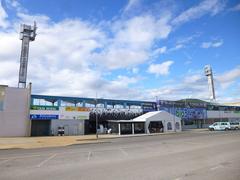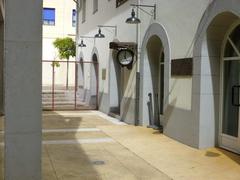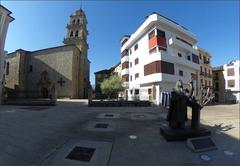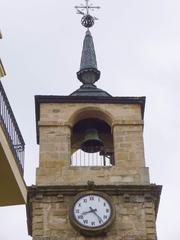
Campo Ponferrada: Visiting Hours, Tickets, and Historical Sites Guide
Date: 04/07/2025
Introduction
Campo, nestled within the municipality of Ponferrada in the El Bierzo region of León, Spain, is a captivating destination for history enthusiasts, pilgrims, and travelers alike. Famed for its deep-rooted historical significance, Campo is set along the mineral-rich Boeza River valley and forms part of the French Way of the Camino de Santiago. Its heritage is intricately connected to Roman settlements, medieval pilgrimage routes, and the enduring legacy of the Knights Templar. Today, visitors can explore remarkable sites such as the Castillo de los Templarios, the Renaissance Basilica de la Encina, and the dramatic landscapes of Las Médulas, a UNESCO World Heritage Site.
This guide brings together essential information on visiting hours, ticket details, accessibility, travel tips, and a curated overview of historical and cultural landmarks in Campo and Ponferrada. Whether you’re arriving by train, bus, car, or on foot along the Camino, use this resource to plan an enriching journey through one of northwestern Spain’s most storied regions. (Ponferrada Official Tourism, Eupedia, Las Médulas UNESCO Site)
Table of Contents
- Historical Overview
- Essential Visitor Information
- Gastronomy and Festivals
- Visual Highlights
- Frequently Asked Questions (FAQ)
- Summary and Visitor Tips
- References and Further Reading
Historical Overview
Roman Origins
Campo’s origins trace back to the era of Roman occupation, as evidenced by archaeological remains such as the Roman-era fountain and hilltop settlements like “El castro.” The strategic location along the Boeza River, with its iron and gold resources, made the area significant for Roman mining and trade. The influence of this period is especially visible in the nearby Las Médulas, the largest Roman gold mine in Spain, now a UNESCO World Heritage Site. (Las Médulas UNESCO Site)
Medieval Growth & the Camino de Santiago
By the 11th and 12th centuries, Campo emerged as a prominent stop on the Camino de Santiago, with its Calle Real forming part of the French Way. The construction of the “pons ferrata” (iron bridge) in 1082 by Bishop Osmundo was pivotal, encouraging safe passage for pilgrims and supporting the region’s economic and cultural development. Medieval hospederías (pilgrim hostels) served travelers for centuries, highlighting Campo’s role as a welcoming stage on the renowned pilgrimage. (Eupedia)
Templar Era & Feudal Transitions
In 1178, the area was ceded to the Knights Templar, who constructed the iconic Castillo de los Templarios to protect pilgrims and secure the region. The fortress, expanded from earlier Roman fortifications, remains one of Spain’s most impressive and best-preserved Templar castles. The dissolution of the Templars in 1311 saw the territory transition to the Crown of Castile, but the Templar legacy endures in architecture and local tradition. The annual Noche Templaria festival revives medieval pageantry and community spirit. (Itinerartis)
Cultural and Religious Traditions
Campo and Ponferrada are celebrated for their vibrant religious and cultural life. The Basilica de la Encina, a Renaissance masterpiece, is the focus of September’s Fiestas de La Encina, while the village’s own San Blas festivities in early February reflect enduring community traditions. The Church of San Andrés and other historic churches demonstrate the rich ecclesiastical heritage of the region. Pilgrimage remains integral to Campo’s identity, attracting travelers from around the world. (Journey Gourmet)
Modern Developments
Economic changes in the late 19th and 20th centuries, including the arrival of the railroad and the rise (and later decline) of mining industries, shaped Ponferrada’s growth. Today, Campo maintains its rural charm, while Ponferrada balances its medieval legacy with thriving tourism, commerce, and cultural events. (Eupedia)
Essential Visitor Information
Visiting Hours and Ticketing
-
Templar Castle (Castillo de los Templarios):
- Hours: April–October: 10:00–20:00; November–March: 10:00–18:00.
- Tickets: Adults €6; children under 12 free; discounts for seniors, students, and groups.
- Purchase: Tickets available onsite or online (official site).
-
Basilica de la Encina:
- Hours: Daily, 9:30–13:30 & 16:30–19:30.
- Tickets: Free entry.
-
Museo del Bierzo:
- Hours: Tuesday–Saturday, 10:00–14:00 & 16:00–19:00; Sundays, 10:00–14:00.
- Tickets: €3 for adults; free for children under 12 and seniors.
-
Las Médulas (UNESCO Gold Mines):
- Hours: Trails open year-round; visitor center hours vary seasonally.
- Tickets: Free access to trails; guided tours €8–€12.
Accessibility
- Major attractions like the Basilica de la Encina and Museo del Bierzo are wheelchair accessible.
- The Templar Castle has partial accessibility due to medieval architecture; some areas involve stairs and uneven surfaces. Assistance is available upon request.
- The historic center has cobblestones and slopes; wear comfortable shoes and plan accordingly if you have mobility concerns.
Getting There
- By Train: Ponferrada station connects with León, Madrid, Santiago de Compostela (winalist.com).
- By Bus: ALSA buses link Ponferrada to surrounding cities.
- By Car: The A-6 motorway offers easy access; car rental is ideal for exploring the rural Campo area and nearby villages.
- By Foot/Bike: Scenic routes connect Campo to the city center along the Boeza River.
- By Air: Nearest airports are León (110 km), Santiago de Compostela, and Madrid.
Best Seasons to Visit
- Spring (April–June) & Autumn (September–October): Mild temperatures and vibrant festivals.
- High Season: July–August; plan ahead for accommodation during pilgrim influx and major festivals.
Top Nearby Attractions
- Santiago de Peñalba Church: Notable Mozarabic architecture.
- Old Town (Casco Antiguo): Explore medieval streets, Renaissance mansions, and lively plazas.
- Wine Country: Tour El Bierzo’s vineyards and sample local Mencía wines (spainthisway.com).
Tours and Events
- Guided walking tours in English and Spanish typically include tickets to main monuments.
- Major events: Fiestas de La Encina (September), Noche Templaria (summer), Harvest Festivals (October).
Gastronomy and Festivals
Enjoy El Bierzo’s distinctive cuisine, with specialties like botillo (cured meat), empanada berciana, and seasonal produce. Tapas bars around Plaza del Ayuntamiento and gourmet restaurants like Muna (Michelin-starred) offer a range of culinary experiences. Festivals feature local music, processions, and food fairs, providing a unique cultural immersion. (Journey Gourmet, barcelo.com)
Visual Highlights
Note: Replace placeholder image URLs with actual images to optimize for SEO and accessibility.
Frequently Asked Questions (FAQ)
Q: What are the visiting hours for Ponferrada’s main attractions?
A: The Templar Castle is open 10:00–20:00 (April–October) and 10:00–18:00 (November–March). The Basilica de la Encina is open daily from 9:30–13:30 and 16:30–19:30.
Q: Do I need to book tickets in advance?
A: For popular sites like the Templar Castle, advance online ticketing is recommended during peak season, though tickets are also available onsite.
Q: Are guided tours available in English?
A: Yes, walking tours of Campo and Ponferrada’s historic center are available in English and Spanish.
Q: Is Campo accessible from Ponferrada train station?
A: Campo is within walking distance or a short taxi ride from the train station.
Q: What local dishes should I try?
A: Sample botillo, empanada berciana, and locally produced Bierzo wines.
Q: Are the main sites accessible for visitors with reduced mobility?
A: The Basilica and Museo del Bierzo are accessible; the castle has partial access.
Summary and Visitor Tips for Campo Ponferrada
Campo in Ponferrada is a destination where centuries of history, vibrant culture, and scenic landscapes converge. From Roman and Templar legacies to pilgrimage traditions and modern gastronomy, this area offers a rich and varied experience. Plan your visit by consulting official resources, consider guided tours for deeper context, and allow time to savor both architectural wonders and local flavors. Download the Audiala app for offline maps, event updates, and insider recommendations.
References and Further Reading
- Ponferrada Official Tourism
- Eupedia
- Las Médulas UNESCO Site
- Journey Gourmet
- Itinerartis
- Turispanish
- Spain This Way
- barcelo.com





